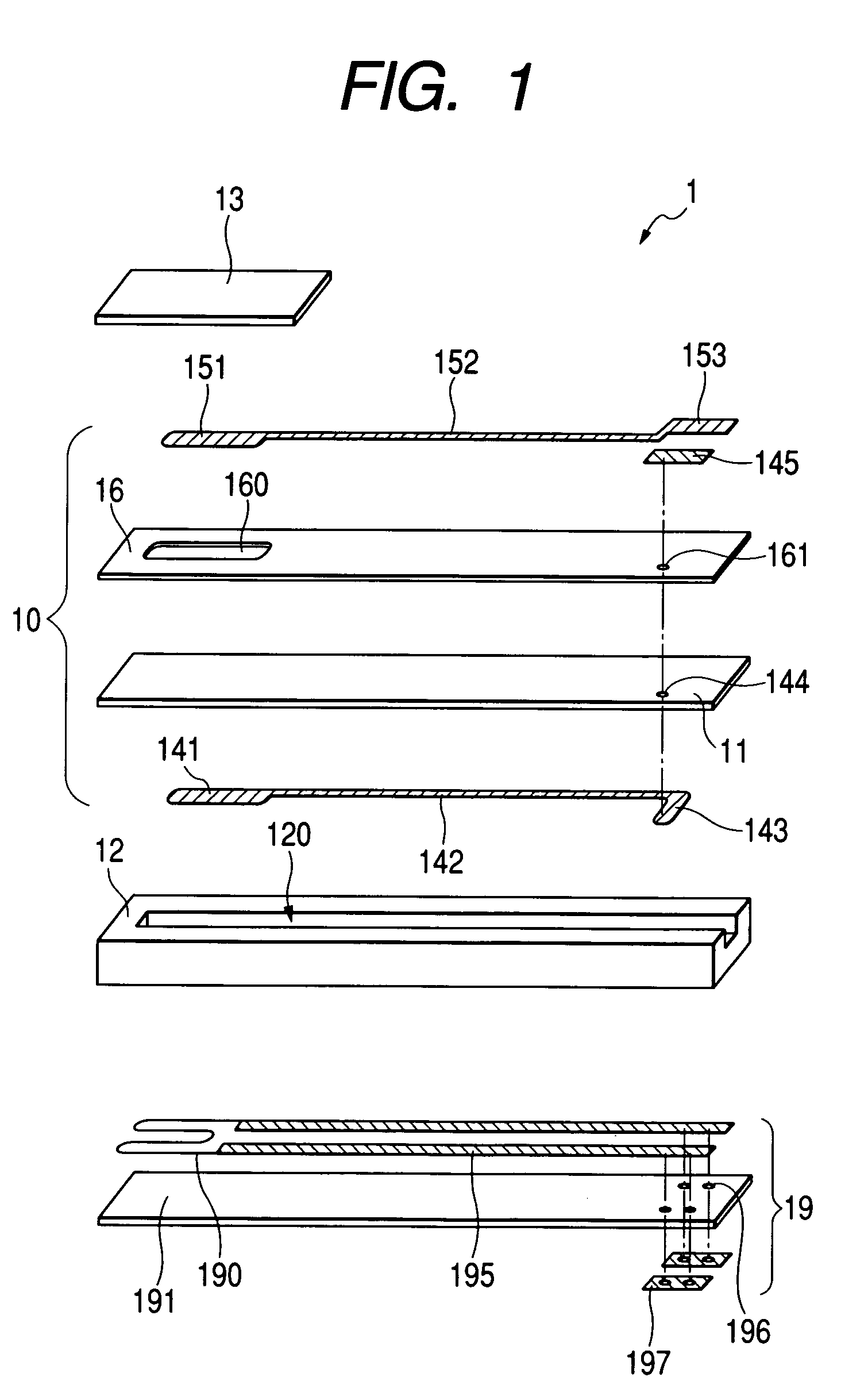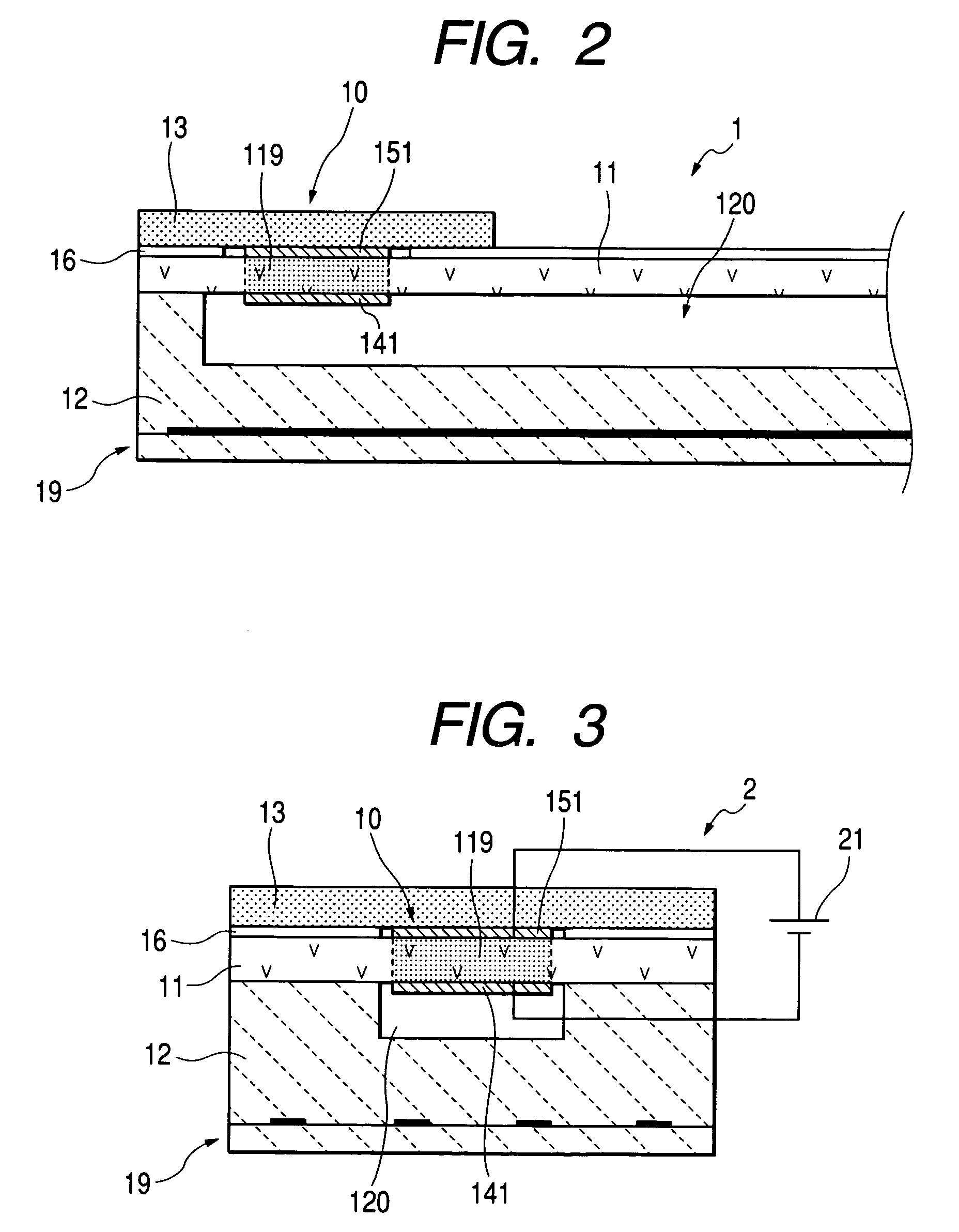Gas sensor element
a sensor element and quick activation technology, applied in the direction of liquid/fluent solid measurement, instruments, electrochemical variables, etc., can solve the problems of difficult to effectively operate the three-way catalyst, difficult to determine the air-fuel ratio, and difficulty in determining the air-fuel ratio immediately after engine startup, so as to improve the conductivity of oxygen ions, reduce the activation temperature, and improve the effect of oxygen ions
- Summary
- Abstract
- Description
- Claims
- Application Information
AI Technical Summary
Benefits of technology
Problems solved by technology
Method used
Image
Examples
first embodiment
[0053]Referring now to the drawings, wherein like numbers refer to like parts in several views, particularly to FIGS. 1, 2 and 3, there is shown a gas sensor element 1 according to the invention which may be incorporated within a gas sensor installed in an exhaust pipe of an automotive engine to measure the concentration of oxygen (O2) or an unburned component contained in exhaust gasses of the engine in order to determine an air-fuel ratio of a mixture supplied to combustion chambers of the engine for use in air-fuel ratio control. An overall structure of such a gas sensor is not essential, and explanation thereof in detail will be omitted here. For example, U.S. Pat. No. 5,573,650, issued Nov. 12, 1996 to Fukaya et al., teaches an oxygen sensor equipped with a laminated sensor element, disclosure of which is incorporated herein by reference.
[0054]The gas sensor element 1 is of a single cell structure which is equipped with an electrochemical cell 10 consisting of a solid electroly...
fifth embodiment
[0084]The present invention is not limited to the A / F sensor and may alternatively be used with a variety of gas sensors such as NOx, HC, and CO sensors (see the fifth embodiment as discussed later).
[0085]While the aging treatment is, as described above, performed using the voltage V between V2 and 2V2, the voltage V lies preferably within a range of 1.2V2 to 1.5V2.
[0086]The aging treatment is preferably performed while the temperature of the gas sensor element 1 is kept at 500° C. to 1000° C. using, for example, the heater 19.
[0087]When the temperature is less than 500° C., it results in a great variation in V2 between individual gas sensor elements, thereby making it difficult to apply the dc current to the electrochemical cell 10 of all the gas sensor elements at the voltage V of V2 to 2V2.
[0088]When the temperature is more than 1000° C., it results in a great variation in degree of the current flowing through the electrochemical cell 10 upon application of the voltage V, which l...
fourth embodiment
[0101]The fourth embodiment will be described below in which the aging treatment is performed on an electromotive force gas sensor element 3 as illustrated in FIG. 11.
[0102]The gas sensor element 3 is made of a laminate of the porous protective layer 31, the solid electrolyte plate 11, the spacer 12, and the ceramic heater 19.
[0103]The solid electrolyte plate 11 has the electrodes 141 and 151. The electrode 141 is, like the first embodiment, exposed to the air chamber 120 and works as a reference gas electrode. The electrode 151 is covered with the porous protective layer 31 and exposed to a gas to be measured.
[0104]The gas sensor element 3 is designed to produce a potential difference between the electrodes 141 and 151 as a function of a difference in oxygen concentration of the reference gas and the measurement gas. The concentration of oxygen (O2) to which the electrode 151 is exposed is determined as a function of the potential difference.
[0105]The porous protective layer 31 has...
PUM
| Property | Measurement | Unit |
|---|---|---|
| temperature | aaaaa | aaaaa |
| temperature | aaaaa | aaaaa |
| temperature | aaaaa | aaaaa |
Abstract
Description
Claims
Application Information
 Login to View More
Login to View More - R&D
- Intellectual Property
- Life Sciences
- Materials
- Tech Scout
- Unparalleled Data Quality
- Higher Quality Content
- 60% Fewer Hallucinations
Browse by: Latest US Patents, China's latest patents, Technical Efficacy Thesaurus, Application Domain, Technology Topic, Popular Technical Reports.
© 2025 PatSnap. All rights reserved.Legal|Privacy policy|Modern Slavery Act Transparency Statement|Sitemap|About US| Contact US: help@patsnap.com



